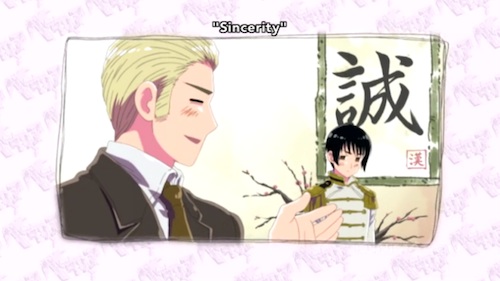I love when the mainstream media tackles anime. Tomorrow’s New York Times’ features a story about the business opportunities in streaming anime. In its discussion of what shows work, the articles drops this great quote: “The small but avid audience is made up of mostly male viewers aged 18 to 34. Distributors said comedies, sports shows and anything aimed at women tend to not work.”

Ouch. Sorry women, the anime companies don’t know what to do with you. They must know you watch anime, but apparently not shows aimed at you. Or at least you don’t on Hulu or Netflix. I suppose no one has heard of Hetalia?
While companies struggle to figure out women, they seem to be connecting with teenage boys. The article cites Naruto: Shippuden as one of the most popular shows on Hulu. Even better, the streaming sites get the content cheap. Netflix pays just a small licensing fee, while Hulu shares some ad revenue. That compares favorably to the large fees both pay for domestically produced content, like Mad Men and Gossip Girl.
It’s heartening to see that streaming anime can be profitable. Even Cartoon Network thinks anime has its place, with a senior VP at Adult Swims explaining, “. . .we’d rather be more interesting and edgy from a programming standpoint, and that means anime.” I hope this means more people will get exposed to anime on sites other than crunchyroll and NicoNico. Or, better yet, that Cartoon Network will add more shows to their broadcast lineup. In the meantime, I guess we’ll try to figure out what these mysterious women want.
Sorry women, distributors don't like you
15 responses to “Sorry women, distributors don't like you”
-
Women, how do they work?
-
It really is interesting, isn’t it? I’m sure the explanation is a complicated one. At least I hope so, and isn’t simply a case of the distributors not caring. Needless to say it’s very sad that they don’t seem to know what to do for 50% of their audience! It goes without saying that certain types of shows will appeal to male viewers – basically, anything with boobs and fighting in it is bound to be popular – but seriously, there’s no shortage of shoujo or josei shows to choose from…and no shortage of potential viewers. What the hell, guys?
Good post, Dengar. It’s what you call a Very Good Question. Well worth asking I think.-
I think you nailed it, anime can’t afford to give up on half its potential audience. I’m struggling right now to decide if distributors are saying they’ve given up or if they are just admitting that no current female oriented show is performing as well as Naruto.
I’m worried it might be the former because I think the info behind the quote came from funimation. The part of the quote about sports shows seems like a direct reference to funimation’s failure with the baseball show Big Windup. After Big Windup Funi said they wouldn’t touch another sports show. I hope they haven’t made a similar decision to abandon women-oriented shows.
-
-
Hetalia = outlier. I imagine Uta no Prince-Sama, Sekai Ichi Hatsukoi, and such aren’t doing a third as good.
-
Hetalia is definitely an outlier, but so is Naruto. Other ninja shows based shows like Nabari no Ou didn’t crack the top 20 on Hulu. It’s not like Hetalia is the only show targeted at women to do well. Ouran High School Host Club is a recent example, but older shows like Inuyasha, Card Captor Sakura and Sailor Moon did great business.
-
-
Don’t forget Fruits Basket that was one of Funimation’s biggest hits.
And I think Princess Tutu (which didn’t do well at first) picked up steam after positive word of mouth.
Finally the Sailor Moon manga which is now being reprinted has done tremendously well even selling out of its first print. I wonder if they brought that series’ anime back how it would do?
Plus I think it’s a little stereotypical to think that women also not like shows aimed at a male audience. Or maybe I just hate the whole target audience thing when I am told what I am supposed to like. -
While I do think that anime has more male than female fans, I definitely don’t think the gap is so great that female fans don’t affect anything. Do they even know how many female fans Naruto has? And I would say that Hetalia’s female fans outnumber males. It always bothers me when these American news items about anime come up because the people writing it and such usually have no clue about what anime is and all that it entails.
But on the bright side, I’m glad that streaming has been a good thing for anime ^_^-
The scary part is that the information comes not from the author of the article, but from anime distributors. The author only quotes three anime business people in the article: 1) Gen Fukunaga, CEO of Funimation 2) Mike Lazzo, senior vice president for programming and production at Adult Swim and 3) Andy Forssell, Hulu’s senior vice president for content. These guys know anime and I’d bet they are the source of the author’s information. If one of them says that shows oriented towards women don’t work, I would bet the numbers support that.
-
-
I’m fully, 100% certain that Western anime companies don’t know squat about marketing anime to women; it seems as if every time a series gains a strong female fan base, it’s almost by accident. Shows like Hetalia and Black Butler weren’t, as far as I saw, marketed towards women using the same sort of tactics that Funimation tends to use when marketing series specifically to male viewers (as I’ve written about in my own blog, they seem perfectly willing to go completely low brow and market boobs and nudity when they feel it’s warranted by the show – both Sekirei and Master of Martial Hearts are the most blatant examples I can think of). While I’m personally no fan of fanservice, if I saw a pattern of the same sort of marketing being aimed at women I’d be more likely to ignore Funimation’s breast-worship, but it’s not the case.
They (“they” being Western anime distributors) seem to be unwilling to eliminate a potential male fan base by direct marketing something to women, but perfectly willing to do the opposite by licensing things that are already kind of infuriating and then marketing the living crap out of them. I wouldn’t be surprised if “we don’t know how to appeal to women” is actually a thinly-veiled “whoops, we made multiple mistakes and alienated a bunch of female fans and don’t know what to do now” even if they don’t actually realize that themselves. I mean, the most marketed-to, coveted viewing demographic among sponsors is males 18-34, right? It doesn’t really surprise me that they’d put a lot of effort towards grabbing hold of that viewership and then turn around and totally flub it when it comes to everyone else.
It’s sad, because when I go to conventions and present panels, I see older men and women in the audience and they’re really trying to grasp for something to watch. They’ve been anime fans for quite a while, but the Western distributors have kind of forgotten that they exist which is funny because, guess what? They’re older, more established, and probably have more money to spend on hobbies like anime collecting than the teen attendees. What’s really painful for me, though, is that more and more of my female friends have drifted from the fandom because they just don’t feel as if there’s anything for them there, when I know that there are some really great series that just never get picked up for distribution in the West that might be right up their alley. Unfortunately it’s come to me and a few others using word-of-mouth in the absence of more official validation from the distributors.
Anyway, I think these things are all symptoms of bigger problems (not giving any sort of validity to women’s stories unless they’re made to appeal towards men being one of the major ones), and that’s certainly not limited to anime culture. Even though it’s nice when an anime distributor manages to throw us a bone once in a while, it’s obvious that they kind of tripped and fell into it rather than consciously decided that the show might appeal to the other half of the anime fan base.
You can tell I have kind of a large investment in this issue, huh? 🙂-
I think American companies have fallen into the trap of looking for easy wins. The industry’s financial problems has decreased risk taking to the point that one bad performance (like Big Windup) leads to an entire genre getting written off. Short term this might be a smart move, but in the long term the companies are writing off large numbers of potential fans.
I think that manga will be the way going forward to keep older, more discerning fans engaged. A company can experiment with manga because the cost of translating and distributing manga is lower than with anime. Hopefully if enough such manga is successful anime companies will take notice.
-
-
An anime’s success here is often because the manga was already available and had a readership, though I don’t have any stats for that. When I worked at a library and was in charge of the graphic novels, I was just amazed at how titles like Fruits Basket and Black Butler flew off the shelves, before (I believe) the anime was readily available.
What’s sad is that anime and manga were supposed to be the things that brought women into the former boys club (at least here in America) that was comics and cartoons.-
I’m hopeful that the move to digital manga will increase the number of titles that are translated and exported to the West. I think that if digital can reduce costs then more of the female oriented manga that is being made in Japan will actually come over here.
-
-
What necessarily says Hetalia is aimed specifically for women? Nothing screams either sex to me… I don’t see why it keeps getting brought up. Sure – it’s hilarious, awesome and innovative, but what it has to do with distributors, not understanding women and their base audiences, is beyond me.
-
I think it would take a column to properly explain why I believe Hetalia is aimed at women. But for the purpose of this post it’s enough to say that Hetalia is a show that is popular with women. Hetalia’s popularity provides an example that contradicts the quote from the article, which is the point the post was trying to make.
-
-
[…] There is always a double standard. For women who like anime, this can pose a problem. […]

Leave a Reply